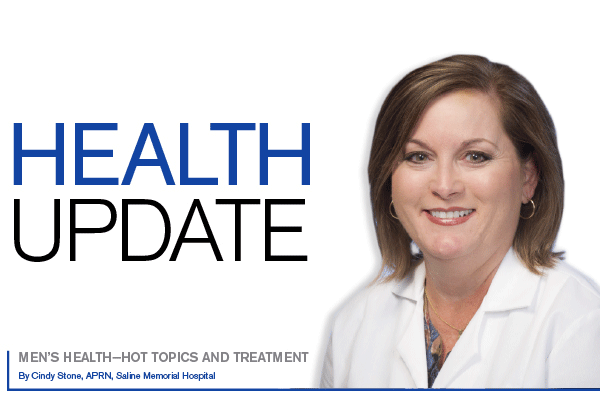Men’s Health—Hot Topics and Treatment

Bryant Medical Clinic recently hosted its first annual Men’s Health Screening. This event was held as a part of Prostate Cancer Awareness month, which is recognized each year in September. Each screening included a prostate exam, PSA and other recommended labs to complete an individualized wellness screening. The goal of our event was not only to provide recommended screenings, but also to engage our male patients in a more proactive approach to their overall health and wellness.
What made this event unique was the men’s focus group that met after the screening. The goal of this group forum was to hear from male patients with various health concerns and to discuss current issues in men’s health. Topics discussed included disparity of healthcare in men, common issues in men’s health and recommended health screenings and immunizations for males of all age groups.
Over the last two decades, the number of men in America with weight and body fat problems has increased steadily. Although not solely a male issue, 73% of men over the age of 20 are classified as overweight or obese (CDC, 2018). It is well understood that obesity and large waist circumference can increase risk for cardiovascular disease, hypertension and diabetes.
Research has shown that obesity can also have an impact on men’s hormonal balance by decreasing testosterone levels, which can have ripple effects on virility and energy. To combat this issue, professionals recommend that males avoid skipping meals, choose foods low in saturated fats, control portion size, avoid sodas and sugars, and avoid eating large meals before sleeping. Regular physical activity is also recommended.
The American Heart Association recommends at least 30 minutes of moderate-intensity aerobic activity at least 5 days per week, for a total of 150 minutes per week (2018), in order to improve heart health and assist with achieving or maintaining a healthy weight.
Hypertension, or high blood pressure is one of the most common conditions in men, and can slowly damage the entire cardiovascular system over time. Over 75 million American adults (32%) struggle with high blood pressure- that is 1 in every 3 adults, (CDC, 2018).
Even more alarming is that high blood pressure was a primary or contributing cause of death for more than 410, 000 Americans in 2014 alone (CDC, 2018). High blood pressure is more common in some areas of the U. S. than in others. Unfortunately, Arkansas lands on the more common side, with a prevalence of high blood pressure coming in at 33%-39% of all adults.
Another concern with high blood pressure is that it typically comes with no warning signs or symptoms, so many people do not realize they have it. The American Heart Association recommends blood pressure measurement at each regular health care visit, or at least once every two years in adults with normal blood pressure, which is 120/80 or less.
It is important that men take an active role in monitoring and preventing high blood pressure before cardiovascular damage can occur. This may include self- monitoring, which can be done at home with a digital blood pressure device, utilizing machines in local stores, and participating in available health screenings.
Other ways to help maintain and control blood pressure include diet and exercise modifications, maintaining a healthy weight, decreasing alcohol and sodium intake, and eating less fat and more vegetables. If you are already diagnosed with high blood pressure, take your medications as prescribed.
Testosterone is the male sex hormone, made in the testicles, which affects muscle growth, bone growth, and sexual function and desire. Over the last decade, prescriptions for testosterone therapy among men ages 40 and older have increased more than threefold.
This trend likely derives in large part from direct–to–consumer marketing campaigns that have targeted middle-aged men, and from the expansion of clinics specializing in the treatment of low testosterone. It is hard to know how many men have low testosterone (Low-T), although the data suggest that overall about 2.1% may have this condition.
Additionally, as few as 1% of younger men, and as many as 50% of men over 80 years old may also have low testosterone levels. Low-T is more common in men who have diabetes or who are overweight. In one research study, 30% of overweight men had Low-T, compared to only 6.4% of those with normal weight. The same study found diabetes to be a risk factor for Low-T as well. In another study, 24.5% of men with diabetes had Low-T, compared to 12.6% of those without diabetes.
Other possible causes of Low-T can be chronic opioid use, certain congenital conditions, and loss of or harm to the testicle. Pituitary disorders, infection, stress, chemotherapy, high-fat or sugar diet, lack of daily exercise, and certain medicines have also been linked to low testosterone levels.
Symptoms of Low-T may include (but are not limited to) low sex-drive, fatigue, reduced lean muscle mass, irritability, ED, and depression. It is important that Low-T be appropriately diagnosed through careful history, physical exam, and laboratory testing. There is a possibility that Low-T may be a symptom of another underlying medical issue.
Most testosterone therapy replacement consists of intramuscular injections, but topical creams and gels can also prove effective. It is important to remember that any form of testosterone should only be prescribed and managed by professionals, preferably those trained in hormone replacement therapy. Such individuals will be able to recognize the appropriateness of therapy, manage medication dosing and administration, and monitor for possible associated side effects. ν









0 comments